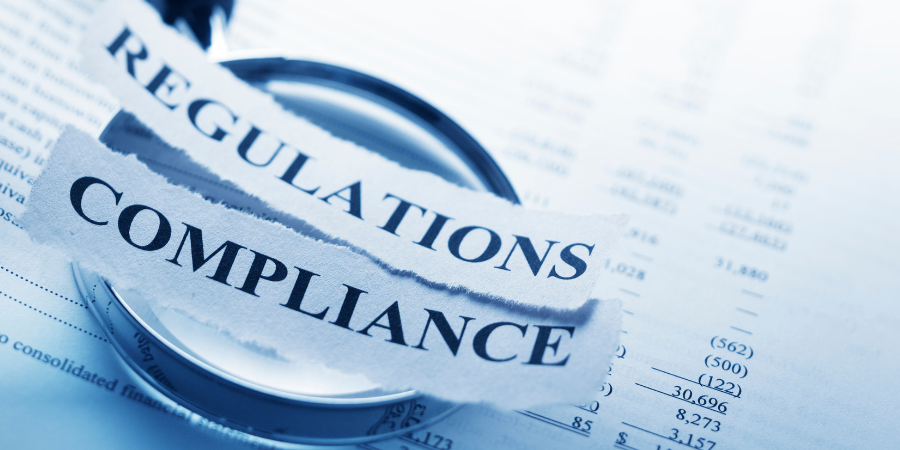What Is Governance, Risk, and Compliance?
Published on January 26, 2024
Last updated on July 30, 2024
Jump to a section
Governance, risk, and compliance (often referred to as GRC) is a framework businesses use to help align IT activities with regulatory compliance requirements and business goals. It is a vital part of business practices and must be implemented at every level – from everyday tasks to the highest of aspirations.
The importance of a robust governance, risk, and compliance policy cannot be understated. When correctly optimised, it can inform decision-making and risk management across all levels. GRC solutions are designed to protect a business no matter the changes it might face. This often includes outside influence from regulatory bodies and industry experts in addition to internal auditing and changes in organisational goals and values.
Though it can appear to be an intimidating process from the outside, it can easily be broken down into key definitions and paths to tread. This guide explores each part of governance, risk, and compliance and suggests what companies can do to align this process with their overall business performance.
What is GRC? Governance, Risk, and Compliance, Explained
Though governance, risk, and compliance come together to create one system, an organisation must understand each part of this framework. Each one is a vital part of the whole in its own right. Additionally, each section will, in turn, feed into and support wider business processes.
By understanding each part of GRC individually, we can better understand how the three sections come together to create one unifying force.
Governance
Governance involves aligning processes and actions and ensuring that they fit with the overall goals of the business. Many governance policies outline the responsibilities and expectations of the board of directors and senior management. These expectations will be balanced with the interests and workloads of employees and suppliers to create realistic targets. It may also include corporate social responsibility and other ethical areas that define how employees are treated by management and the company at large.
Risk
Every business will face a large list of risks regardless of their industry. Therefore, business leaders need to ensure that they have good risk management processes in place to either avoid these adverse events altogether or to minimise the fallout from their impact. From financial and security risks to strategy and legal issues, management needs to have plans in place to deal with conflicts as they arise. Risk assessment and management is a key part of a successful business's journey.
Compliance
Every industry is managed by a group of regulatory bodies. These could be government departments, or they could be independent third parties with the authority to work, enforce, and prosecute if needed. Compliance sets standards that a business must hold themselves to and ensures that there are fair and equal working conditions throughout the industry. These are very real legal and regulatory requirements, and so any organisation must adhere to any compliance requirements set for them as strictly as possible.
Why does your organisation need GRC?
To put it in the simplest of terms, governance, risk, and compliance are not something that businesses can just choose to opt out of.

Each part of GRC affects the organisation and its plans. If a business wants to ensure that they have lasting success and a good reputation in their industry and beyond, they need to have a good GRC strategy in place.
Depending on the nature of a business's industry, GRC framework might even be a legal requirement. Many industry regulators require evidence to show that compliance standards are being met. Likewise, businesses often have to produce written governance strategies to show that they do have a framework in place. Finally, effective risk management can keep a company afloat as they can foresee issues ahead of them and deal with them efficiently should they arise.
Why is GRC important today?
A good GRC system will help stakeholders make clear and responsible decisions in risk-prone environments. Across the organisation, regardless of department or status in the company hierarchy, an employee should have an understanding of protocols and what they can and can't do.
The right GRC strategy will protect and uphold several areas of the business. This can result in several bonuses to the business, such as:
Decision-making backed by real-time data
GRC software and other tools used to monitor this framework will provide frequent and detailed data scripts that should then be used to inform future decisions. The time frame between the generation of this data and its implementation will also be much shorter. The right GRC tools will monitor and manage rules to ensure that data is being modelled and used correctly.
Strong organisational culture
Since a large part of governance, risk, and compliance is bound up in the organisation of the organisation, a natural by-product of implementing this strategy is going to be a strong organisational culture embedded at every level. Ethical decisions shall be a natural part of company operations, and company culture should naturally develop an inclusive and growth-centred mindset.
Improved cybersecurity measures
Risk management is a big part of any GRC strategy, and all modern businesses should look to protect their data security. It is rare to find a business nowadays that does not deal with online data in some way, and small businesses can often find themselves as the target of cyber attacks more often than larger corporations. The threat to user data is, unfortunately, very real, and so businesses should look to comply with, for example, GDPR (General Data Protection Regulation) and other regulations.

What does a weak GRC strategy look like?
It is not enough to simply produce a basic GRC framework and hope that this is sufficient to reliably achieve objectives. Using a tailored GRC program should aim to fix holes and issues that may be in existing frameworks, but that does not mean that the act of creating one is enough. A weak GRC framework can cause as many issues as having none at all, and it might have some of the following attributes:
Outdated information
First and foremost, a weak GRC strategy will most likely have outdated information and practices in it. Any risk management strategies are likely to not be up to code, and there is potentially a compliance risk as laws and legal frameworks will have progressed since the strategy will have initially been completed.
Industry and government regulations can move forward incredibly quickly and can be reformed on multiple occasions across a very short space of time. This can cause issues for an organisation, as their employees might be perfectly compliant with the strategy as it stands, but are not compliant with the wider guidelines.
Poor organisation and lack of visibility
How can you expect employees to be vigilant in their risk management and able to maintain compliance and security protocols if there is poor organisational structure and a lack of visibility across areas of risk?
It is very common for GRC practices to become divided and isolated between different departments – a process referred to as siloing. If, as an example, Legal and Marketing are both actively practising governance, risk, and compliance across their tasks, they should be aware of each other's activities. A lack of visibility across this area could result in poor management and the duplication of tasks and responsibilities.
High running costs
Understandably, poor organisation and a lack of visibility across an organisation will inevitably lead to higher running costs. If two people are both performing the same task, they will both require resources to do so, and this pushes up the cost of GRC activities overall.
What's more, a poor GRC strategy could mean that resources are being allocated incorrectly. There may be some risks being monitored that do not need as much attention as they are currently receiving. Day-to-day activities might also be sidelined in favour of GRC ones, and this could result in GRC activities taking up more resources proportionally than they should.

Poor ability to manage risk
Of course, one always has to consider risk management when discussing a GRC framework. Though acts like cybersecurity threats and financial liabilities might be heavily considered in a risk management strategy, there is always a chance that other areas could be flagged for risk-prone activities.
If a GRC program only has scope for several scenarios, there is a greater chance of issues slipping past and risk mitigation being limited in what it can actually do.
Lack of direction
What is the plan for the company's governance, risk, and compliance strategy overall, and how does this align with business objectives? Whatever overarching plans senior management and executive stakeholders might have for the company, they always need to align with any governance and compliance requirements.
As a result, all teams must work towards the same objectives and be aware of the blockers and needs of other departments working around them. Business processes can be handled by many hands as each one is fulfilled, and all must be committed to creating a risk-aware culture or accept the likelihood of a risk-prone working environment, something no business can thrive in.
How to implement a GRC system
As every business will have different needs, there is no one-size-fits-all approach to implementing a GRC system. As a business's strategic objectives organically shift and industry guidelines evolve, so will the GRC framework. Two companies could start with identical programs and goals, but as they diverge in performance and needs, their programs will have to change and diverge, too.
Nevertheless, there are some basic steps that all organisations should undertake when looking to introduce a new GRC system:
1. Assess objectives
It is always best to start with an end goal in mind. What are the objectives the organisation as a whole wishes to move towards?
This is a crucial step as it will help to define resource management further down the line. Though there will always be some practices that will move forward regardless of industry or department, there might be some areas that require more focus than others.
An internal audit will be crucial here to establish any similarities between departments and teams. This will aid those charged with creating the integrated GRC approach in seeing precisely where there are shared processes and any areas that might be in danger of becoming siloed.
When discussing objectives, it is also vital to consider the legislation and regulations that could affect operations. Those creating the new GRC program need to discover all regulatory frameworks the system has to align with and work to ensure that full compliance is in place from the moment the new system is live.
2. Establish structure
Once objectives have been created, all departments and tools have to be brought onto the same page. By creating a shared language to be used when discussing regulatory compliance, there is no risk of a detail being confused. No matter who looks at the data or why they need to understand the analytics, they should be able to accurately process it.
Start with senior management, as they are the ones who need to be able to implement it top-down if they are to create a risk-aware culture in the workplace. They will be the ones to create and set policies and processes, and any GRC solutions proposed should reflect this.
This is also the time to consider adopting a new GRC software or some other system that will support the proposed objectives. Bringing everything together in one integrated GRC approach can prevent details from being lost by the wayside and places all documentation and protocols in one location.
Structure is a vital part of creating a robust GRC framework. Without taking the time to establish it, an organisation only runs the risk of poor compliance and governance and a waste of resources.
3. Identify obstacles and risks
With a structure and objectives created, it is time to identify obstacles that could prevent optimal performance and reduce risk across all processes. This stage can help address uncertainty from employees who might be nervous about implementing a whole new strategy into their working day. They might also be concerned that they have previously not performed risk management adequately and thus could have compromised the company in some way.
This is, therefore, the stage of implementing the new GRC program where a lot of reassurance may have to be delivered to the team. Their compliance management skills may need to be refreshed, and they may need further training. Whatever it takes to assure the team that they can move forward confidently with the new system.
It is also worth looking ahead with third-party relationships and any regulatory bodies that might have an impact on the organisation's future objectives. With regulatory requirements constantly being updated, it is always worth keeping an eye on the future and the changes that might need to be made. Just because a GRC program perfectly meets guidelines now does not mean that it won't be impacted in the future. These changes in regulatory compliance might then have a knock-on effect on clients and partners. Pre-empting these changes can allow for adjustments before it ever becomes an issue.

4. Implement new strategies
At this stage, you should have a full framework managed by GRC software and ready to implement across the full business. If employees require additional training in an area such as risk management, cyber risk, or even just using the software itself, this is the time to deliver it.
Sometimes, it can be best to run a small-scale test first before implementing the strategy across the entire organisation. By running the proposed GRC program across one department or even just a single team, the project leaders will be able to see if the new proposals are viable or if they need further adjustment. Teams may even be able to run a crisis simulation, such as a cyber attack, to see if the new GRC model can withstand such an event successfully.
5. Monitor and optimise
With the new GRC software rolled out across the company, it can be easy to consider that this is the task completed. However, regulatory compliance can change at any moment, and therefore the parameters set in any GRC tools might need to be adjusted and optimised.
Risk management and mitigation will be part of the onboarding of any new tasks introduced to the company. No manager should forget the ongoing task of addressing risks that might occur across existing processes. When a protocol has been set in stone for a long time, there is the risk that employees can become complacent when completing it.
Ensuring that a system of regular internal audits takes place might seem like over-optimisation, but it can actually be crucial for maintaining the integrated GRC activities established.
Improve your governance, risk, and compliance today
An effective GRC program should be able to manage risk and compliance activities effectively, offering continuous monitoring and real-time data in support of this. As industries adapt and change, teams need to ensure that they are adequately supported when managing risks and seasons of change.
Competent GRC efforts will form a major part of business continuity efforts. A business should not have to ground to a halt in order to achieve compliance, as they should never be at risk of becoming uncompliant in the first place.
By integrating a robust GRC policy as part of business continuity efforts, a company should be confident that any effort on their part will always align with the latest guidance in terms of good governance, active risk management, and full industry and regulatory compliance.
C2 Meridian is ready to help your business actively manage risk and change with our cutting-edge business continuity management software. Book a demo with us today, and find out how we can help your organisation move forward even in times of uncertainty.
Written by Aimee Quinn
Resilience Manager at Continuity2
With an Honours degree in Risk Management from Glasgow Caledonian University and 6+ years in Business Risk and Resilience, Aimee looks after the design and implementation of Business Continuity Management Systems (BCMS) across all clients. From carrying out successful software deployments to achieving ISO 22301, Aimee helps make companies more resilient and their lives easier in the long run.


Written by Aimee Quinn
Resilience Manager at Continuity2
With an Honours degree in Risk Management from Glasgow Caledonian University and 6+ years in Business Risk and Resilience, Aimee looks after the design and implementation of Business Continuity Management Systems (BCMS) across all clients. From carrying out successful software deployments to achieving ISO 22301, Aimee helps make companies more resilient and their lives easier in the long run.